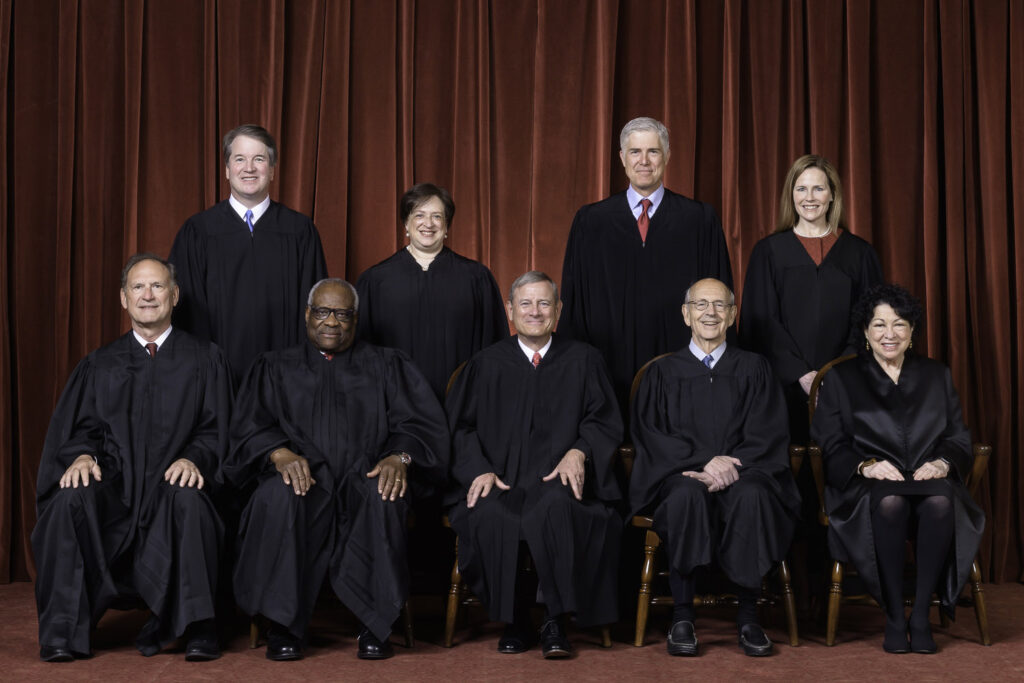A SCOTUS Thought
A direct (albeit a tad snarky) statement on what reform we need.

How about this: eighteen-year terms on the Court, with a vacancy every two years. Every president gets two appointments per term. This would create a far more direct connection to elections and would also diminish the current stakes at confirmation hearings (given that current appointments can change the Court for decades).
Couple this with a robust ethic code that severely curtails gifts even (especially, perhaps) from “close friends.” Further, there would need to be significant curtailments on the kinds of jobs spouses can have during this period. Call it a reasonable swap for having that much power. Once you are off the court, are your billionaire buddies still want to take you on fancy trips you can know that, yes, they really, really like you. Likewise, your spouse can cash in as they see fit knowing that it is their own talents bringing in the bacon.
Recognizing the difficulties getting to the above, it is simply what we need.
If anything, it will alleviate the need for Justices to have to rationalize getting to live the lifestyles of the rich and famous and/or rationalize the lack of recusals.
Let me stress that there is nothing wrong with insisting that having as much power as SCOTUS Justices have that it is reasonable to ask for certain accommodations. After all, it is not like they are being drafted. They can always say no if the terms are too steep. They are neither demigods nor philosopher-kings. They are public servants, but at least some of them have forgotten this fact.






Damn, that was close to what I was thinking about, only I would expand it to 18 justices and have two platoons of justices to keep SCOTUS active year-round and give presidents two picks every other year. Or many have one platoon do all the admin and docket stuff while the other platoon is in session and make them all work year-round.
Maybe even have a draft at the beginning of each term like the NFL picking the two teams of platoons just to give the news shows something to talk about 🙂
I mean as long as we’re just spitballing 🙂
@Rick DeMent: I’d be happy to expand. Nine really is too few.
This is both thoughtful and bold. I mean, yeah, we’d be much off with smart and decent people like Dr. Taylor making the rules.
So what should happen is to — as this erstwhile McCain Democrat did — stop voting for the dishonest, radical right extremist Republican party that has placed dishonest, radical right extremist judges on the court. We should stop falling for their smears of decent, dedicated, patriotic public servants like Obama, Hillary, and Biden. Then we could get some needed reform. And better judges also.
I believe your proposal wouldn‘t require an amendment to The Constitution. So, I can see a relatively straightforward path to getting what we need.
1) Elect a Democratic trifecta in 2024. (Not out of the question if the GOP House continues its current overreach and Biden has coat tails in the Senate)
2) Dispose of the filibuster (again not that big a stretch with Manchin & Sinema likely gone, plus Senate coat tails)
3) Get Dr. Taylor on an advisory board for SCOTUS reform (tell me who to call)
Well, you would have to cover the case where the Senate decides it’s not going to hold confirmation hearings. Or going to vote “No” on anyone the president nominates.
I don’t see why the number of justices has to be fixed by legislation. Why not simply require a new justice to be appointed every two years, and stipulate that a bench of at least eight justices may exercise the functions of the Court?
Add a rider that “The Senate shall be deemed to have consented to the appointment within 90 days of the President seeking its advice, unless it shall before that time advise that it does not consent.”
@Scott F.: I think Congress can do most of this under their Article I powers but it would almost certainly take a Constitutional amendment to go from lifetime terms (as specified in Article III and has been the practice since 1789) to 18-year terms.
@Steven: I do think something like this makes sense and is by and large reasonable. I’m not sure what other government jobs come with stipulations for spousal employment but SCOTUS is unique. I’d extend some of these rules to Members of Congress as well. And perhaps raise salaries for both to something more befitting their status.
I believe that the CIA has some rules/restrictions, but most of that is tied to the inability of Americans to work in host countries.
I have long been an advocate of rotating cycles on the SCOTUS by district court chiefs.
They’d still have lifetime terms, but SCOTUS duty lasts twelve years, then they return to their duties on the circuit court. Each circuit court would have a “representative” on the Supreme Court, but you couldn’t predict the exact people you’d get for any given case because of the rotating memberships.
This would spread out the power, would help with succession planning at the circuit court level, and would create natural retirement incentives for chiefs coming off their SCOTUS rotation which would encourage new blood on the courts.
I’m not even sure we’d need anything more than Congressional legislation to get it done.
Great start to the conversation. Eighteen year terms would be great, but hard to fathom that would come to pass in the whole schme of things. However, allowing the POTUS to pick two Justices each term makes sense and is a lighter legislative hurdle to overcome. Also, if we can’t get rid of the lifetime appointments, I like to the idea of increasing the number on the SCOTUS and having two groups of justices, one that is comprised of the most recent appointees, which hears and decides cases before the court, and, two, a second group that consists of longer serving justices (18+ years service) that carries out the administrative functions of the court. Moreover, the spouse proposal is unworkable, as the grift would then be more in play for the children, relatives, and other associates of the justices. Such spouses and other family members should be required report their income sources, while non-reporting should be made a felony with mandatory prison terms.
I agree entirely. Sadly, judicial reform in general and Supreme reform specifically make far too much sense (and would impact the rich and elite far too much) to ever be allowed.
@James Joyner:
I dunno. Has the going rate for empty suits and lying weasels gone up?